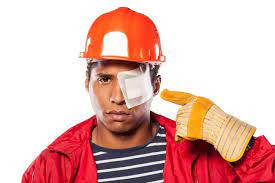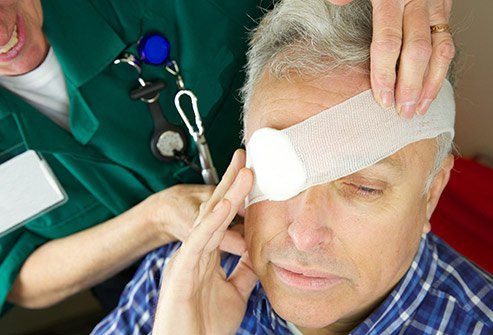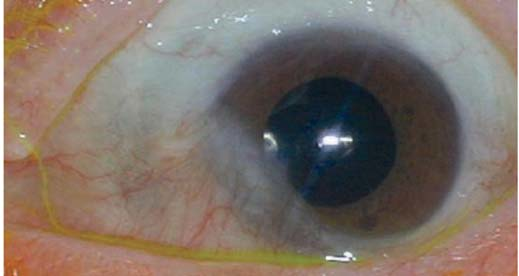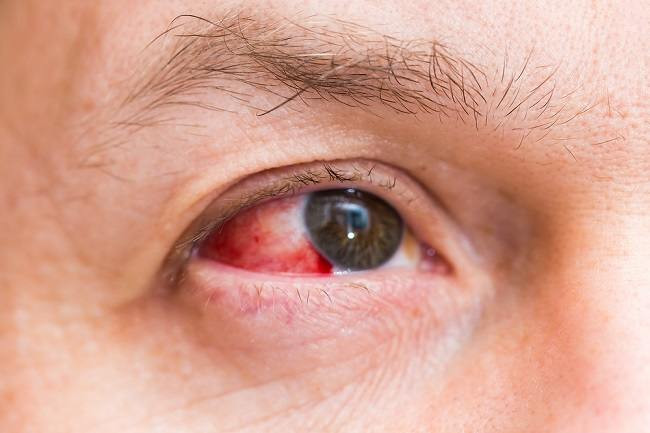Definisi
Trauma kelopak mata adalah tindakan sengaja maupun tidak sengaja yang menimbulkan perlukaan kelopak mata. Kerusakan ini akan memberikan penyulit sehingga mengganggu fungsi mata sebagai indra penglihatan. Trauma kelopak mata, meliputi trauma pada jaringan lunak kelopak mata dan daerah di sekeliling mata. Trauma ini dapat dikelompokkan menjadi trauma kontusio, avulsi, tusukan dan laserasi. Pada kasus luka memar dan lecet pada kelopak mata dapat diobati dengan antibiotik topikal dan kompres dingin, sedangkan pada trauma avulsi, tusukan dan laserasi pada kelopak mata dan daerah disekelilingnya harus dilakukan pemeriksaan lebih lanjut dan dirujuk ke dokter spesialis mata.
Penyebab
Penyebab trauma pada kelopak mata ada beberapa, yaitu:
- Kontusio, yaitu kerusakan yang disebabkan oleh kontak langsung dengan benda dari luar terhadap kelopak mata, tanpa menyebabkan robekan pada kelopak mata. Trauma kontusio ini dapat menjadi salah satu penyebabnya terjadinya hematoma kelopak mata, yaitu pembengkakan atau penimbunan darah di bawah kulit kelopak akibat adanya pembuluh darah kelopak mata yang pecah. Hematoma kelopak mata sendiri merupakan kelainan yang sering terlihat pada trauma tumpul kelopak mata.
- Laserasi, yaitu mengacu pada kerusakan sebagian atau seluruh ketepalan kelopak mata. Laserasi kelopak mata dapat terjadi sebagai akibat dari 2 mekanisme trauma yaitu kontak dengan benda tajam yang bergerak dengan kecepatan tinggi sehingga menembus struktur kulit dan mengakibatkan kerusakan sebagian ketebalan atau menembus hingga struktur yang lebih dalam (yaitu bola mata). Selain itu, dapat disebabkan cedera avulsi akibat trauma tumpul.
Pada anak-anak sebagian besar kasus trauma kelopak mata terjadi akibat gigitan anjing, jatuh, benturan benda tajam menjadi penyebab paling sering, dan trauma tumpul yang paling sering terjadi adalah dari tinju, kecelakaan kendaraan bermotor dan olahraga bola menjadi penyebab paling sering pada remaja dan dewasa.
Faktor Risiko
Trauma kelopak mata dapat terjadi di segala usia meliputi anak-anak, dewasa dan orang lanjut usia. Pada orang lanjut usia trauma kelopak mata biasa akibat terjatuh. Beberapa faktor risiko yang dapat meningkatkan kejadian trauma kelopak mata, seperti:
- Faktor lingkungan
- Faktor aktivitas dan pekerjaan
- Jenis kelamin laki-laki lebih sering terkena trauma kelopak mata dibandingkan perempuan. Hal ini dapat berkaitan pula dengan pajanan pada aktivitas sehari-hari.
Gejala
Gejala trauma kelopak mata dapat meliputi:
- Kemerahan
- Bengkak
- Rusaknya jaringan di sekeliling kelopak mata
- Luka robek
- Perdarahan aktif
- Nyeri pada kelopak mata hingga bola mata
Apabila gejala semakin parah dan berlanjut, atau trauma kelopak mata yang terjadi lebih berat, maka dapat ditemukan gejala berikut ini:
- Pandangan buram
- Kebutaan
Diagnosis
Diagnosis trauma kelopak mata dapat ditegakkan melalui wawancara mendalam (anamnesis) mencakup mekanisme trauma terjadi, apakah trauma benda tajam atau tumpul sertai perlu di evaluasi juga perkiraan ketajaman penglihatan sebelum dan sesaat setelah cedera. Harus diperhatikan apakah gangguan penglihatan bersifat progresif lambat atau memiliki onset mendadak. Harus dicurigai adanya benda asing yang masuk ke dalam bola mata juga.
Selanjutnya dapat dilakukan pemeriksaan fisik seperti pemeriksaan tajam penglihatan, lapang pandang, posisi bola mata dan otot mata, pemeriksaan kelopak mata, pemeriksaan bagian depan mata dengan menggunakan senter, tes floresensi untuk melihat apakah terdapat robekan pada kornea, serta pemeriksaan menggunakan slit lamp.
Pemeriksaan mata bagian belakang dilakukan dengan menggunakan oftalmoskop serte diberikan obat yang memperbesar pupil terlebih dahulu untuk mempermudah pemeriksaan. Karena penting untuk memeriksa bola mata secara keseluruhan walaupun luka terkesan hanya di kelopak mata. Selanjutnya dapat dilakukan pemeriksaan tekanan bola mata. Apabila terdapat kecurigaan retak pada tulang-tulang sekitar mata dapat dilakukan pemeriksaan CT scan.
Tata Laksana
Penatalaksaan pada kasus trauma kelopak mata yaitu lindungi mata dengan kain bersih, kemudian cuci luka hingga bersih dengan air mengalir. Pada kasus perdarahan yang masih aktif, tekan selama 10 menit dengan kasa steril untuk menghentikan perdarahan. Pada kasus perdarahan aktif yang tidak berhenti dengan di tekan, maka disarankan untuk segera dibawa ke dokter untuk dijahit guna menghentikan perdarahan. Apabila terdapat pembengkakan dapat dikompres es yang dimasukkan dalam sehelai kain kemudian di tekankan pelan pelan ke bagian mata yang bengkak selama 20 menit. Jika nyeri tidak tertahankan dapat diberikan obat pereda nyeri seperti acetaminophen atau ibuprofen. Apabila mata menjadi hitam akibat adanya darah menumpuk pada bawah kulit bagian tersebut, tidak perlu khawatir karena tidak berbahaya dan tidak memerlukan perawatan khusus dan dapat hilang dengan sendirinya selama beberapa hari. Pada kondisi trauma berat, dapat dilakukan operasi untuk menanganinya.
Komplikasi
Komplikasi yang dapat terjadi seperti bekas luka terutama pada trauma tajam, infeksi bola mata, kebutaan dan yang paling parah yaitu kehilangan bola mata biasanya apabila kerusakan sudah berat dan menghindari penyebaran kejaringan sekitar.
Pencegahan
Benda yang dapat menembus kelopak mata hingga bola mata sering mengakibatkan hilangnya penglihatan. Pada anak-anak, jangan berikan benda-benda yang memiliki risiko mengenai mata seperti, jangan biarkan anak bermain benda tajam, senapan udara (BB gun), jangan biarkan anak-anak mendekati seseorang yang dalam pekerjaannya terdapat serpihan yang dapat masuk ke dalam mata seperti orang yang sedang menggunakan mesin pemotong rumput. Awasi anak-anak ketika bermain dengan hewan seperti anjing atau kucing untuk mencegah agar tidak tergigit maupun tercakar. Pada orang yang bekerja atau tinggal di lingkungan yang berisiko tinggi terdapat serpihan yang dapat masuk ke mata, gunakan pelindung mata.
Kapan Harus ke Dokter?
Segera pergi ke dokter apabila luka terjadi pada kelopak mata menyebabkan kulit sobek dan memerlukan jahitan, pendarahan aktif dari kelopak mata, luka mengenai mata sehingga menimbulkan rasa sakit di mata sangat berat, mata terus berair atau berkedip, penglihatan kabur atau hilang di salah satu mata, ukuran pupil tidak sama, ada darah atau kabut di belakang kornea, terdapat riwayat benda keras mengenai mata dengan kecepatan tinggi, benda tajam mengenai mata. Pada kondisi anak-anak terutama dibawah 3 tahun, segera periksakan ke dokter apabila mata anak anda tertutup dan mereka tidak mau membukanya, memiliki penglihatan ganda, terdapat mata hitam atau terjadi perdarahan dibagian putih bola mata.
Ingin tahu informasi tentang penyakit lainnya seputar mata? Yuk simak informasinya di sini ya!
- dr Ayu Munawaroh, MKK
Eyelid Laceration – EyeWiki. Eyewiki.aao.org. 2021
Cochran M, Czyz C. Eyelid Laceration. Ncbi.nlm.nih.gov. 2021
Eyelid Injuries and Problems. WebMD. 2021











